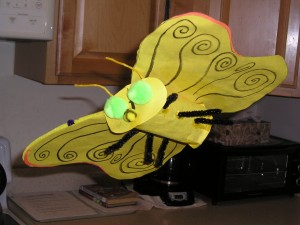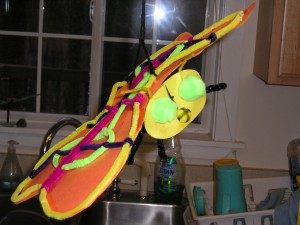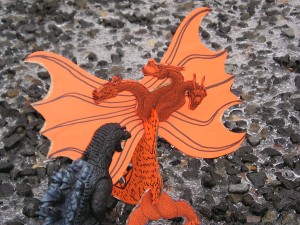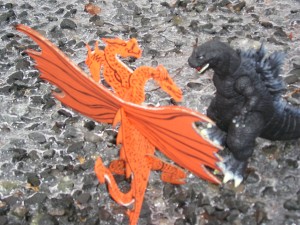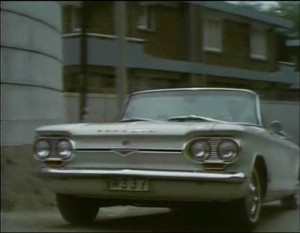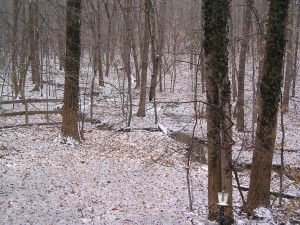My youngest son, Judah, continues to request handmade monster toys, so I continue to make them. My first efforts were Gorgo and Tarantula (seen here in this earlier post). Gorgo was a simple paper puppet, two layers of construction paper glued together over a straw. Tarantula, however, was a more elaborate project, involving two plastic token cups from Chuck E. Cheese’s, a ball of black yarn, and several dozen black pipe cleaners. I made sure to over-build that sucker, reinforcing his legs six ways to Sunday (or eight ways to Sunday, given the number of legs).
Next up, per Judah’s instructions, was Mothra. Making a Mothra isn’t too hard; making a Mothra that won’t get destroyed after one or two sessions of play is a taller order. Mothra’s body is a cardboard toilet paper roll, coated in yellow construction paper, with pipe cleaner legs inserted through holes. Her wings are two layers of construction paper, reinforced on top with “veins” of variously colored pipe cleaners (which also give the wings some stiffness). Her head is construction paper with fuzzy ball eyes and antennae made of Bendaroos (wax-coated string). So far, she has avoided mortal damage, and she has been in Judah’s hands for over a month. So I guess I must’ve built her right.
Having seen the “Ghidorah Trilogy” (Ghidorah, the Three Headed Monster; Monster Zero; and Destroy All Monsters), of course Judah would want a Ghidorah for his collection (and professionally made Ghidorah toys aren’t too common, at least not here in the States). I’d originally intended to make a simple two-dimensional Ghidorah puppet, along the lines of what I’d done with Gorgo, but then I got a bit more ambitious. I couldn’t figure out a workable way for me to make him fully three-dimensional, but by making his heads, wings, torso, and legs separately and then slotting them together, I was able to make him at least partially three-dimensional, plus able to stand on his own (a definite plus in a household inhabited by a kitten who loves to chew paper).
I printed out a nice, cartoony drawing of Ghidorah from the deviantart.com site and cut out portions to use for the fronts of Ghidorah’s heads and legs, the most difficult parts to draw, then drew the wings and torso freehand. I did my best to draw the reverse sides of his legs and feet and of his heads and necks on another sheet of construction paper, plus reverse sides of his wings and torso. I then traced the parts onto a sheet of corrugated cardboard, which would give all the parts the necessary stiffness. I cut everything out, glued the construction paper “skins” over the cardboard “skeleton,” and then, after it had all dried, cut slots into the various parts and slotted and glued them together, sort of like how you would put together a cardboard model of an airplane. My finished product didn’t come out exactly proportional (the torso and wings are too big for the heads and legs), but he turned out exactly the right scale to battle Judah’s plastic Godzilla, which is more important. And from certain angles, he is rather impressive, if I do say so myself. Besides, Ghidorah was always sort of a lumpy, ungainly monster, anyway, at least in the original 1960s Toho films.
This past week was a bad one, health-wise, for my family. One by one, we all came down with bouts of stomach flu. Judah and Asher caught it nearly simultaneously, and while they were on the mend, I stayed home with them to give Dara a bit of a break. The three of us watched Yongary, Monster From the Deep (1967). This was one giant monster picture I had somehow not managed to see as a kid. Yongary is essentially a South Korean Godzilla, with the monster-loving little kid from Gamera, the Invincible tossed in for good measure. The model cities weren’t bad, at least on par with those seen in the early Gamera movies, but the monster costume was a step down from those featured in the Gamera creature-fests, about as silly looking as the average kaiju in an episode of Ultraman.
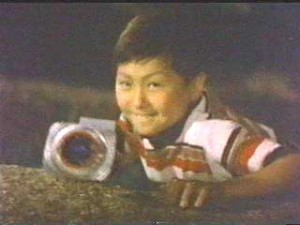
The worst thing about Yongary, Monster From the Deep--the heroine's absurdly obnoxious little brother, Icho
What made the film stand out in my eyes were two things — the hero drove a splendid 1964 Chevy Corvair convertible, and Icho, the six or seven-year-old kid whom the filmmakers unwisely (and sadistically) foisted on us for much of the film, was simply the most detestable and obnoxious child character I have ever witnessed in any monster movie, ever. Worse than any of the kids in the Gamera movies (even that horrid, virtually unwatchable little Caucasian girl who wore a Scottish tam in War of the Planets). Worse than the kid in Godzilla’s Revenge. Worse, quite possibly, than any of the kids in The Lemon Drop Kids Meet a Brooklyn Gorilla (although I’ll admit I haven’t seen that one, so I can’t say for certain). One gizmo that plays a role in the movie’s plot is an itching ray (yes, an itching ray) developed by the hero (for God knows what reason; he’s already invented it when the film begins, before Yongary ever appears). The first time we meet Icho, he is hiding in the bushes, having stolen his new brother-in-law’s invention, and he zaps his sister and her new husband with the itching ray as they drive past (in that splendid Corvair convertible), forcing them to pull over and jump out of their clothes while they are on their way to their honeymoon. Icho gets even more obnoxious as the film rolls on. At one point, the hero scientist and the military have found a way to render Yongary unconscious, after he has knocked down most of those parts of Seoul that weren’t already knocked down during the Korean War. What does cute little Icho do? He steals the itching ray again, runs to the giant monster’s side, and wakes him up. Just as a goof, you know. Yongary then proceeds to knock down those parts of Seoul he missed the first time around. At that point, I was rooting for the big lizard to squash the kid already. Doesn’t happen. Evil triumphs; Yongary dies.
But enough about itch-inducing child actors. We got a bit of wet snow last night, enough to lightly coat our back yard and replenish our stream. Knowing I’d be posting about giant monster movies, I began wondering whether any of them had taken place in the wintertime, during a heavy snowfall. Dozens of them took place in the desert, in the American Southwest, near where the atomic tests were carried out. All of the Japanese kaiju movies that I can recall took place in the summertime, with the exception of the early parts of Gigantis the Fire Monster / Godzilla Raids Again, the second Godzilla movie, in which Godzilla (or a second Godzilla-like creature, the original having been thoroughly disintegrated by the oxygen destroyer at the close of Godzilla, King of the Monsters) and Anguilus are discovered fighting each other on a northerly, ice-covered island, before they both invade Japan. The Deadly Mantis begins in Antarctica, where the titular giant bug makes his first attack on humanity, but when he gets up to the cities of North America, it is summertime. Much of Ray Harryhausen’s Sinbad and the Eye of the Tiger, which features numerous giant creatures, takes place in a mysterious region of the Arctic, but that’s more a fantasy-adventure film than a traditional “giant monsters attack” movie. I haven’t seen The Beast From Twenty Thousand Fathoms in a long time, and I seem to recall that its climax takes place in Coney Island during a storm. Was it a snowstorm? If anyone has a good memory for this kind of thing, help me out here. I just think it would be neat to see New York City or Washington, DC or Tokyo (or even Seoul) get attacked by a gigantic lizard during a beautiful snowstorm.
(Ah, memory just kicked in; Peter Jackson’s New York City scenes in his recent remake of King Kong took place in the wintertime, one of the nicer touches in that film. Digital effects make much possible that perhaps weren’t so practicable during the era of miniature models.)

